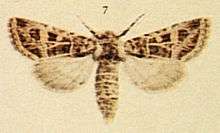Leucochlaena oditis
The Beautiful Gothic (Leucochlaena oditis) is a Palearctic moth of the family Noctuidae, sub-family Cuculliinae. It is found in southern Europe and north Africa, with occasional finds on the southern coast of England.[1]
| Leucochlaena oditis | |
|---|---|
 | |
| Scientific classification | |
| Kingdom: | |
| Phylum: | |
| Class: | |
| Order: | |
| Family: | |
| Genus: | |
| Species: | L. oditis |
| Binomial name | |
| Leucochlaena oditis (Hübner, 1822) | |
| Synonyms | |
|
Noctua oditis Hübner, 1822 | |
Technical description and variation
L. oditis Hbn. (= hispida H. G., pilosa Bsd., hirta Dup. nec Hbn.) (29 c). Forewing deep olive brown: all the veins whitish; inner and outer lines broadly whitish with a dark line in centre, the first outwardly oblique, the outer outcurved above and oblique below middle, emitting pale tooth-shaped marks along veins to submarginal line which is broad, whitish internally and rufous or brownish externally, toothed between the black marginal lunules; the line is preceded by black wedge-shaped blotches lying between the teeth of outer line; claviform stigma brown, black-edged; upper stigmata pale ochreous, finely outlined with black, the orbicular with the centre reddish; fringe with basal half brown, outer half ochreous; hindwing dull whitish, becoming brownish grey towards termen, with a dark outer line; specimens from the chalk at Portland [South England] are much paler and constitute the aberrations pallida Tutt and obsoleta Tutt; the former pale grey with a faint brown tinge; the costa whitish; the broad submarginal line white like the fringe; hindwing and fringe almost wholly white; the latter is dull grey with scarcely any paler markings; ab. hispanica ab. nov. (29 c, d) differs in being smaller, yellower brown, with all lines, veins, and markings ochreous, not white, except the inner linear edge of the submarginal line; it in distinguished at once by the lower half of outer line being vertical instead of oblique, in a straight line with the inner edge of the reniform. Larva yellowish green or brownish; dorsal and subdorsal lines pale with dark edges; spiracular line broad, yellowish white.[2]The wingspan is 28–36 mm[3]
References
- Markku Savela. "Leucochlaena oditis". funet.fi. Retrieved 6 January 2013.
- Warren. W. in Seitz, A. Ed., 1914 Die Großschmetterlinge der Erde, Verlag Alfred Kernen, Stuttgart Band 3: Abt. 1, Die Großschmetterlinge des palaearktischen Faunengebietes, Die palaearktischen eulenartigen Nachtfalter, 1914

- Ian Kimber. "2226 Beautiful Gothic Leucochlaena oditis". UKMoths. Retrieved 6 January 2013.
- Wikisource:The Moths of the British Isles/Chapter 15#267